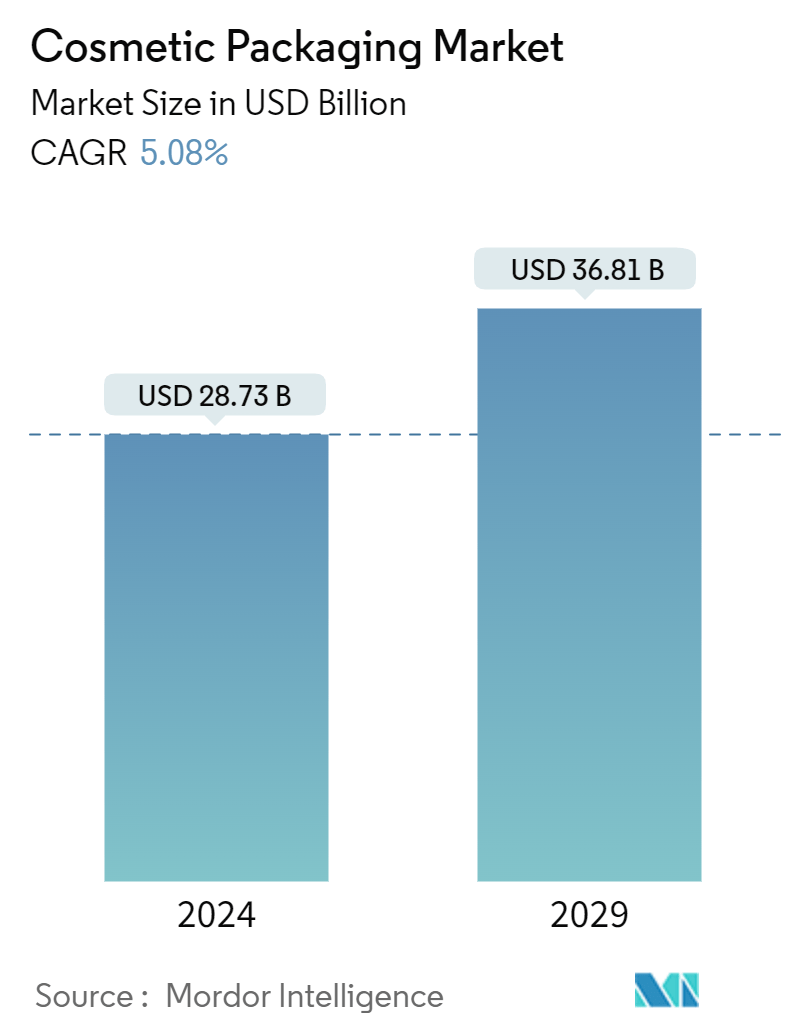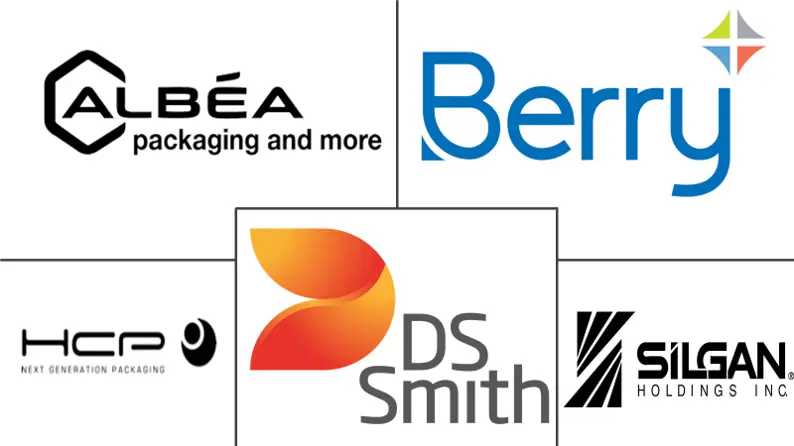Market Size of Cosmetic Packaging Industry

| Study Period | 2019 - 2029 |
| Market Size (2024) | USD 28.73 Billion |
| Market Size (2029) | USD 36.81 Billion |
| CAGR (2024 - 2029) | 5.08 % |
| Fastest Growing Market | North America |
| Largest Market | Asia Pacific |
Major Players
*Disclaimer: Major Players sorted in no particular order |
Cosmetic Packaging Market Analysis
The Cosmetic Packaging Market size is estimated at USD 28.73 billion in 2024, and is expected to reach USD 36.81 billion by 2029, growing at a CAGR of 5.08% during the forecast period (2024-2029).
- The cosmetic packaging market has witnessed significant growth. Cosmetic packaging predominantly utilizes materials like glass, paper, and plastic. These materials are crafted into various products, ranging from containers and bottles to various shapes, sizes, and dispensing mechanisms. Plastic, a versatile material, serves as both primary and secondary packaging in various forms, from flexible pouches and caps to closures and nozzles. The use of plastic tubes is significant in cosmetics as they can store a range of materials, dispense products precisely, and offer superior contamination protection over their counterparts.
- The cosmetics industry has distinct packaging needs. With a collective push to combat plastic pollution, the industry is turning to innovative packaging and enhanced formulations. Glass boasts non-porous and impermeable qualities. Its chemically inert nature ensures products remain untainted. Beyond functionality, glass elevates the product's aesthetic, offering consumers a transparent view of the contents, including color, a key factor in their purchase decision.
- Market vendors are focused on innovating new products as part of their business expansion. For instance, in October 2023, SGD Pharma showcased its advanced glass packaging at the Luxe Pack Monaco event. The highlights were the fragrance mini samplers and the Eclipse refillable glass jar. SGD Pharma's portfolio features the Constellations line, offering diverse shapes tailored for skincare and nutraceutical uses.
- The post-COVID-19 economic resurgence led to a notable growth in consumer spending on grooming and beauty products. This surge, particularly toward premium offerings, fueled the demand for glass bottles and containers for packaging. Emerging economies, such as India and other Southeast Asian nations, are set to bolster this trend, generating robust demand for cosmetics, especially those elegantly presented in glass packaging.
- However, establishing a manufacturing unit for cosmetic packaging requires significant capital investment, primarily for large furnaces and machinery. Given the emphasis on aesthetic appeal, cosmetics necessitate packaging designs that not only attract but also stand out on shelves. Consequently, companies are increasingly turning to glass packaging solutions to captivate customers, albeit at a higher design cost. Global packaging vendors face external pressures due to heightened governmental regulations advocating for sustainability and eco-friendliness in manufacturing practices.
Cosmetic Packaging Industry Segmentation
A cosmetic substance is used to clean, enhance, or change the appearance of the face, body, hair, fingernails, or teeth. Cosmetic products include make-up, perfumes, skin creams, nail polish, and grooming products such as soap, shampoo, shaving creams, and deodorants. The study tracks the different types of packaging needed for cosmetic products to keep them from spoiling, moisture, UV, and more.
The cosmetic packaging market is segmented by material (plastic, glass, metal, and paper), product type (plastic bottles and containers, glass bottles and containers, metal containers, folding cartons, corrugated boxes, tubes and sticks, caps, and closures, pump and dispenser, droppers, ampoules, and flexible plastic packaging), cosmetic type (hair care, color cosmetics, skincare, men grooming, and deodorants), and geography (North America [the United States and Canada], Europe [the United Kingdom, Germany, France, Italy, Spain, and Rest of Europe], Asia-Pacific [China, India, Japan, South Korea, and Australia & New Zealand, and Rest of Asia-Pacific], Latin America [Brazil, Mexico, Argentina, and Rest of Latin America], and Middle East and Africa [the United Arab Emirates, Saudi Arabia, South Africa, and Rest of MEA]). The market sizes and forecasts are provided in terms of revenue (USD) for all the above segments.
| By Material Type | |
| Plastic | |
| Glass | |
| Metal | |
| Paper |
| By Product Type | |
| Plastic Bottles and Containers | |
| Glass Bottles and Containers | |
| Metal Containers | |
| Folding Cartons | |
| Corrugated Boxes | |
| Tubes and Sticks | |
| Caps and Closures | |
| Pump and Dispenser | |
| Droppers | |
| Ampoules | |
| Flexible Plastic Packaging |
| By Cosmetic Type | |
| Hair Care | |
| Color Cosmetics | |
| Skin Care | |
| Men's Grooming | |
| Deodorants | |
| Other Cosmetic Types |
| By Geography*** | ||||||||
| ||||||||
| ||||||||
| ||||||||
| ||||||||
|
Cosmetic Packaging Market Size Summary
The cosmetic packaging market is experiencing significant growth, driven by the diverse packaging needs of the cosmetics industry. This sector requires a variety of materials, including glass, paper, and plastic, to create packaging solutions such as containers and bottles with different shapes, sizes, and dispensing mechanisms. The demand for premium cosmetic products is on the rise, particularly in emerging economies, which is boosting the need for high-quality packaging materials like glass. Glass packaging is favored for its premium appeal and ability to protect product integrity, while plastic offers versatility in primary and secondary packaging solutions. Companies in the industry are focusing on innovation to meet the evolving demands, with new products and designs that enhance both functionality and aesthetic appeal.
The market is characterized by a growing emphasis on sustainability and environmental awareness, with consumers increasingly preferring eco-friendly packaging options. This trend is particularly evident in the skincare segment, where there is a rising demand for organic and natural products, necessitating packaging solutions that preserve product quality and align with sustainability goals. The United States and Canada are key markets, with regulatory standards influencing packaging practices. The industry is fragmented, with numerous global and regional players investing in innovative and recyclable packaging materials to meet consumer preferences and regulatory requirements. As the market continues to expand, the focus on sustainable and functional packaging solutions is expected to drive further growth and innovation.
Cosmetic Packaging Market Size - Table of Contents
-
1. MARKET DYNAMICS
-
1.1 Market Overview
-
1.2 Market Drivers
-
1.2.1 Increasing Consumption of Cosmetic Products
-
1.2.2 Increasing Focus on Innovation and Attractive Packaging
-
-
1.3 Market Restraints
-
1.3.1 Growing Sustainability Concerns
-
-
1.4 Industry Value Chain Analysis
-
1.5 Industry Attractiveness Porter's Five Forces Analysis
-
1.5.1 Bargaining Power of Suppliers
-
1.5.2 Bargaining Power of Buyers
-
1.5.3 Threat of New Entrants
-
1.5.4 Threat of Substitute Products
-
1.5.5 Intensity of Competitive Rivalry
-
-
-
2. MARKET SEGMENTATION
-
2.1 By Material Type
-
2.1.1 Plastic
-
2.1.2 Glass
-
2.1.3 Metal
-
2.1.4 Paper
-
-
2.2 By Product Type
-
2.2.1 Plastic Bottles and Containers
-
2.2.2 Glass Bottles and Containers
-
2.2.3 Metal Containers
-
2.2.4 Folding Cartons
-
2.2.5 Corrugated Boxes
-
2.2.6 Tubes and Sticks
-
2.2.7 Caps and Closures
-
2.2.8 Pump and Dispenser
-
2.2.9 Droppers
-
2.2.10 Ampoules
-
2.2.11 Flexible Plastic Packaging
-
-
2.3 By Cosmetic Type
-
2.3.1 Hair Care
-
2.3.2 Color Cosmetics
-
2.3.3 Skin Care
-
2.3.4 Men's Grooming
-
2.3.5 Deodorants
-
2.3.6 Other Cosmetic Types
-
-
2.4 By Geography***
-
2.4.1 North America
-
2.4.1.1 United States
-
2.4.1.2 Canada
-
-
2.4.2 Europe
-
2.4.2.1 United Kingdom
-
2.4.2.2 Germany
-
2.4.2.3 France
-
2.4.2.4 Italy
-
2.4.2.5 Spain
-
2.4.2.6 Rest of Europe
-
-
2.4.3 Asia-Pacific
-
2.4.3.1 China
-
2.4.3.2 India
-
2.4.3.3 Japan
-
2.4.3.4 South Korea
-
2.4.3.5 Austrlia and New Zealand
-
2.4.3.6 Rest of Asia-pacific
-
-
2.4.4 Latin America
-
2.4.4.1 Brazil
-
2.4.4.2 Mexico
-
2.4.4.3 Argentina
-
2.4.4.4 Rest of Latin America
-
-
2.4.5 Middle East and Africa
-
2.4.5.1 United Arab Emirates
-
2.4.5.2 Saudi Arabia
-
2.4.5.3 South Africa
-
2.4.5.4 Rest of MEA
-
-
-
Cosmetic Packaging Market Size FAQs
How big is the Cosmetic Packaging Market?
The Cosmetic Packaging Market size is expected to reach USD 28.73 billion in 2024 and grow at a CAGR of 5.08% to reach USD 36.81 billion by 2029.
What is the current Cosmetic Packaging Market size?
In 2024, the Cosmetic Packaging Market size is expected to reach USD 28.73 billion.

